The Great Central Road: Drive from Laverton to Uluru (with a Caravan)
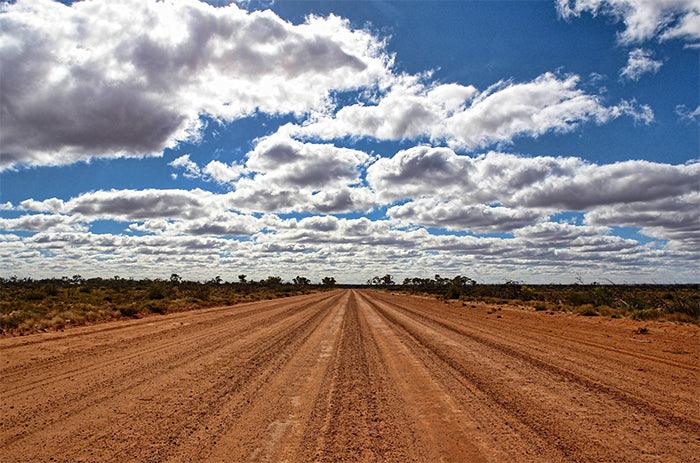

Quick Facts about the Great Central Road
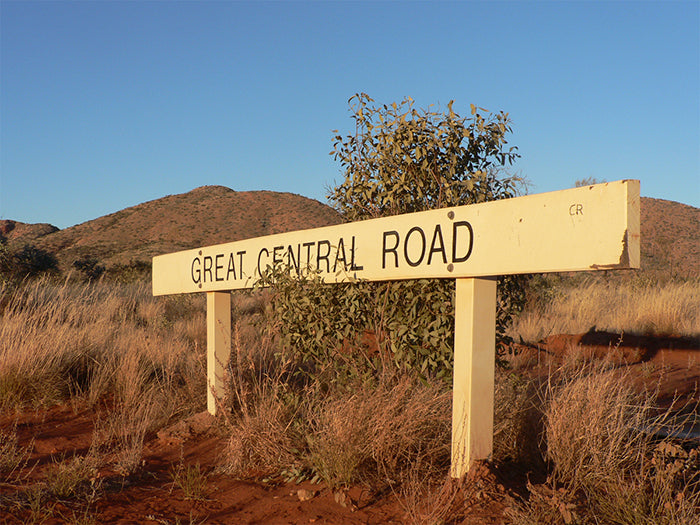
Driving The Great Central Road
Part of the outback way, fuel stops on the great central road.
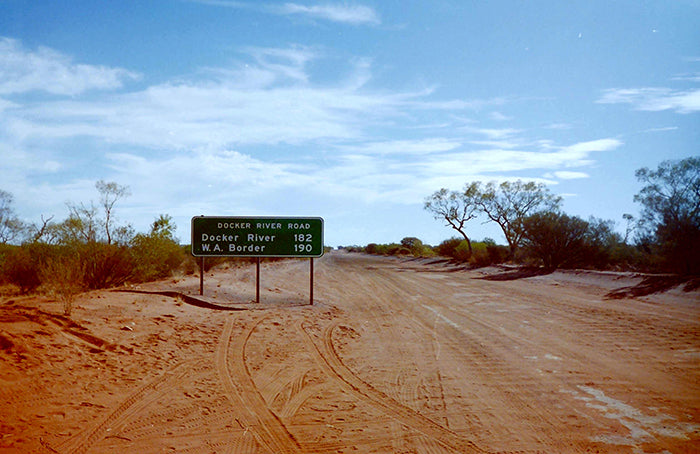
Driveable With a Caravan in Tow
- Tjukayirla Roadhouse
- Paradise Camp
- Warburton Roadhouse
- Yarla Kutjara Campground
- Warakurna Roadhouse
- Kaltukatjara Campground-Docker River
- Curtin Springs
- Stuarts Well
- Alice Springs
Food & Supplies on The Great Central Road

Great Central Road Conditions
Great central road permits.

Great Central Road Attractions
- 300 km into the trip, you come across the Tjukayirla Rockholes and the Paine & Barclay surveyor market adjacent to them which were placed there in the early 1930s. Near the Tjukayirla roadhouse there are animals shapes in the rocks and escarpment caves to discover.
- The Giles weather station is still operational, so you can see the launch of the weather balloon and tour the facilities. The original Gunbarrel Highway Construction Company grader is on display at Giles.
- The Gill Pinnacle near the WA/NT border offers beautiful views. Don't miss Lasseter’s Cave and the stunning Petermann Ranges.
- There is an art trail from Laverton to Alice Springs so be sure to have a look at the beautiful designs of local artists.
- There are several interpretive panels along the road giving you an insight into the history, flora and fauna of the area. Visitor centres can give you current information at Laverton, Yulara and Alice Springs but in between ask the locals for information and tips.
- There is no shortage of wrecked cars and camels to count along the trip.
- The Hema Great Desert Tracks Western Sheet includes topographical relief and touring points of interest. The map shows camping areas, caravan parks, facilities, services and fuel stops plus helpful information on what to take when travelling in the desert.
Safety Checklist
- Great Central Road map
- Two Spares for Car and Van
- A toolkit, tyre tube and repair kit
- 4WD recovery kit including high lift jack, snatch strap, shovel, jacking plate, rope & shackles
- 20 litres of water per person
- Hat and sunscreen
- Warm clothes and bedding for cold desert nights
- Enough food for a few days
- EPIRB if you are leaving the main road
- Enough fuel for at least 400 km
- First aid kit suitable for outdoors
Featured collection
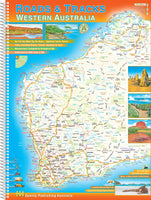
Western Australia Roads & Tracks (16th Edition)

Guide to Free Campsites 2024

World Scratch Map Deluxe

The Complete Fishermans Guide Queensland & Great Barrier Reef

The AIATSIS Large Wall Map of Indigenous Australia
On the blog

May 27, 2024
Books We Are Loving In May

Sep 15, 2023
The Five Best Wildflower Hikes in WA's South West

Aug 31, 2023
Father's Day Ideas for Dads That Love to Travel
Stay up to date.
Sign up for the latest Chart & Map shop news.
- Azerbaijani
- Chinese (Simplified)
- Chinese (Traditional)
- Haitian Creole
- Kinyarwanda
- Kurdish (Kurmanji)
- Kurdish (Soranî)
- Odia (Oriya)
- Scots Gaelic
Apply for a permit to access or travel through Aboriginal land
Important Information
Some Aboriginal communities may require you to provide proof of vaccination against COVID-19 in order to gain entry to or through their community.
Travel permits for Aboriginal reserves
Most people passing through or visiting communities on Aboriginal Lands Trust reserves proclaimed under Part III of the Aboriginal Affairs Planning Authority Act 1972 (the Act) must obtain an Aboriginal Affairs Planning Authority (AAPA) Lands Permit (ALPS) to comply with the Act.
Please note, ALPS is not to be used for mining activity on Aboriginal Lands. The Mining Entry Permit process is outlined below for your information.
Please note that permits to transit between the Northern Territory Border and Laverton along the Great Central Road are issued for a maximum period of three days and two nights only . If you are unable to transit through the Ngaanyatjarra Lands within three days, you should seek an alternative route.
When seeking a travel permit for along the Great Central Road (or other roads in the area) for the purpose of Transit and refuelling ONLY, please select the road(s) you wish to travel for ease of application.
Applying for a travel permit online
Before applying for a permit, please read the permit information and user guide documents.
Permit Information - Aboriginal Lands Permit System - December 2018 (PDF, 279.03KB)
AAPA Lands Permit System User Guide (PDF, 12.04MB)
Plan your journey
Please check the interactive map if you are unsure whether your journey passes through these lands.
Please note that the map is unavailable during the following times (Western Australian time):
- Monday, Tuesday, Thursday, Friday: 02:00AM – 03:30AM
- Wednesday: 00:30AM – 03:30AM
Mining entry permits for Aboriginal reserves
If your mining activity (this includes exploratory/prospecting activity) requires a Mining Entry Permit and/or ‘Consent to Mine’ due to being situated on a protected Aboriginal reserve, you must make an application to the Minister for Aboriginal Affairs for permit access and/or ‘consent to mine’ advice.
The Department of Planning, Lands and Heritage requires the following for assessment to provide a recommendation to the Aboriginal Lands Trust (ALT)/Minister for Aboriginal Affairs regarding ‘mining entry’ and ‘consent to mine’:
- Evidence of formal consultation from the relevant native title body.
- Evidence of formal consultation from the relevant leaseholder (if required).
- Complete the mining entry and consent to mine application form.
The form must be submitted online or to the permit mailbox [email protected] by the deadline set for the ALT meetings .
If you have any queries on the mining entry permit process, please contact the Department of Planning, Lands and Heritage via telephone or email:
1300 651 077
+61 8 6551 8000
Aboriginal Lands Trust - Application Form Mining Entry Permits and Consent to Mine (PDF, 181.74KB)
Mining on ALT pastoral leases
The ALT is the lessee of 6 Pastoral Leases, some of which have been sub-leased. Some communities are the occupants of a pastoral lease but do not have a sublease.
Under section 118 of the Mining Act 1978 and regulation 64 of the Mining Regulations 1981 , the applicant of a tenement situated on a pastoral lease is required to notify the lessee within 14 days of making the application.
In this case, the ALT is the lessee and as such, upon receiving notification, advises the mining company to consult with the sublessee and/or occupants of the leasehold land.
The sublessee and/or occupants have an opportunity to object to the grant of the tenement should they wish through the Department of Mines, Industry Regulation and Safety Mineral Titles online.
ALPS Frequently Asked Questions
what is the permit application process.
Where are AAPA reserves?
View the interactive map .
Am I exempt from a permit?
You do not need an AAPA Permit if you are:
- a person of Aboriginal or Torres Strait Islander descent
- a member of either House of Parliament of the State or Commonwealth Governments
- a person lawfully exercising a function under the Aboriginal Affairs Planning Authority Act 1972 or otherwise acting in pursuance of a duty imposed by law
- a person authorised in that behalf under the Aboriginal Affairs Planning Authority Act Regulations 1972
For more information please read “permit information” in the user guide.
How long will it take to get a permit?
This depends on whether you are travelling to an area where it is necessary to consult with a consultative body. Please ensure that you submit your application well in advance of your trip, especially if you are travelling as a convoy, a 4WD club or a commercial tour operator.
What type of permit do I need?
Where do I get information on road conditions?
Visit the Main Roads website .
My travel dates have changed. What do I do?
If your dates have changed significantly, please contact the Department of Planning, Lands and Heritage via telephone or email on 1300 651 077 or +61 8 6551 8000 or email [email protected] .
Are AAPA permits free?
Yes. Transit permits are free of charge. However, some Aboriginal communities levy an entry/camping/activity fee for people wishing to visit or remain on the reserve for an extended period, such as when tourists stay over for fishing activities. These visitors’ passes/levies are not managed or administered by the Department of Planning, Lands and Heritage. If you are entering a national park you will need to contact the Department of Biodiversity, Conservation and Attractions, Parks and Wildlife Service to see if you need a park pass. Visit the Canning Stock Route website if you are travelling on the Canning Stock Route.
I have made a mistake on my permit application. What do I do?
If you have any queries on the ALPS process, please contact the Department of Planning, Lands and Heritage via telephone or email:
Provided by
Address: 140 William Street PERTH WA 6000 Locked Bag 2506 Perth WA 6001 Telephone: 61 8 6551 8002 Department of Planning, Lands and Heritage website Contact our regional offices General enquiry form Complaints, compliments and feedback form
- Facebook share (Opens in a new tab/window)
- Twitter (Opens in a new tab/window)
- LinkedIn (Opens in a new tab/window)
What did you like about it?
Don't include any personal information. If you need a response, send an enquiry instead.
How can we make it better? *
Acknowledgement of country.
The Government of Western Australia acknowledges the traditional custodians throughout Western Australia and their continuing connection to the land, waters and community. We pay our respects to all members of the Aboriginal communities and their cultures; and to Elders both past and present.

Great Central Road Permits, Fuel And Supplies. What You Need To Know.
If you’re planning to travel the Great Central Road , you’ll need information on permits, fuel and supplies. Read on…
Note: This information is subject to change. Call a few of the communities before you leave to confirm they still have fuel and supplies, as they can close without notice.
Transit Permit
Fuel and supplies, where to camp, road conditions.
Before you leave you’ll need one Transit Permit, as you’ll be travelling through Aboriginal land in the Northern Territory. It is:
- Permit to Transit Aboriginal Land for ULURU TO WA BORDER. Go here to apply .
This permit is free and easy to obtain online.
Make sure your permit is accessible on your phone or tablet so you can show it when required.
Permits are easy to get and are free of charge. People often moan about getting a permit, why they need one and so on. Well, you’re travelling through other peoples’ land. So to my way of thinking, a permit is perfectly reasonable.
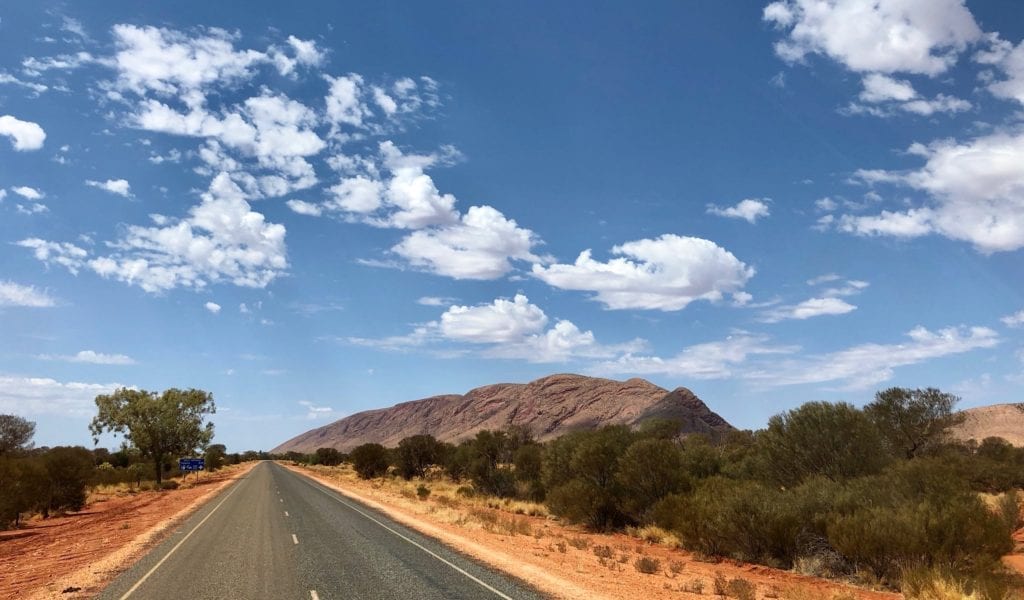
Aboriginal land is no different to driving through a pastoral lease. You’d ask the station owner for permission to drive through their land, so why should Aboriginal land be any different?
One final comment to keep in mind. The permits last for three days.
Fuel is available at Laverton, Cosmo Newbery, Tjukayirla, Warburton, Warakurna, Docker River and Yulara. Be aware they all have unusual opening times and may close at lunchtime. Weekends, they are only open for a few hours.
Check opening times before you leave. All quality maps should have contact numbers. Call before you leave, if you’re concerned about opening times.
As expected fuel is expensive out here. Hardly surprising given the distances involved.
You can get basic supplies wherever you buy fuel. Keep in mind though, their supplies are solely reliant on the delivery truck arriving on schedule. And out here, a delivery truck can easily be delayed by several days. Therefore you shouldn’t rely on these stores.
If you’re looking for places to camp, we’ve compiled list of possible campsites along the Great Central Road here.
For more information on the Great Central Road Conditions, go here .
The Great Central Road permit is easy to apply for. Make sure you get one, otherwise you could be refused entry to a community where you intended to buy fuel or food.
If you find any additional places or changes, please let me know in the Comments below, and I’ll add them to this article.
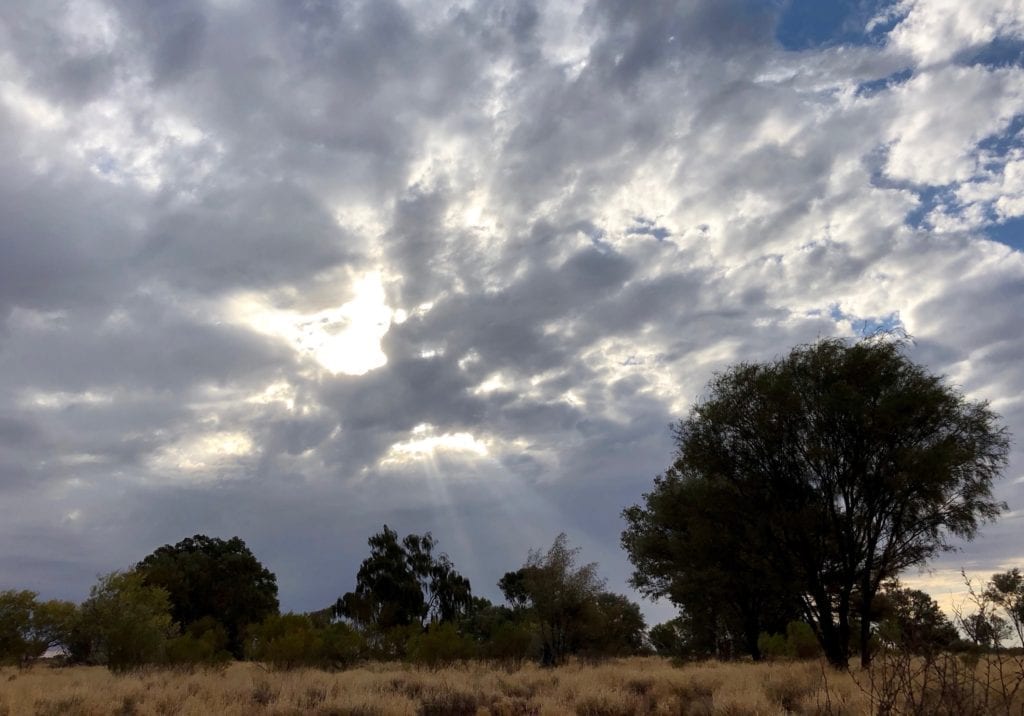
Most importantly, Have a fantastic trip. It’s such a beautiful drive.
The Great Central Road passes through Tjalkanti, Ngaanyatjarra, Ngaanyatjarra, Mandjindja, Ngatatjara and Pitjantjatjara Country.
For more articles on The Outback Way, go here.

Get your Traveller’s Guides
… and a whole lot more at our FREE RESOURCES Page!
Any questions or comments? Go to the Comments below or join us on Pinterest , Facebook or YouTube . Any errors or omissions are mine alone.
2 thoughts on “Great Central Road Permits, Fuel And Supplies. What You Need To Know.”
Is the availability of permits likely to be effected by the current Coronavirus as we are looking at applying for permits earlyMay 2020
Hi Richard, The latest advice from here: https://www.clc.org.au/index.php?/articles/info/transit-permit-application “Due to health risks for community members any non-resident travel to remote communities in Central Australia should be reconsidered other than required travel for health, supply and essential services personnel. Non-essential travel to or through remote communities in Central Australia is not recommended at this time due to the CV19 transmission risk. Any issued permits are invalid if permittee has travelled to any of the countries listed in the Australian Government travel advisories within last 14 days.” So it looks like they are saying to avoid non-essential travel. Hope this helps. Cheers, Andrew
Leave a comment Cancel reply
This site is protected by reCAPTCHA and the Google Privacy Policy and Terms of Service apply.
- Blue Mountains
- Central Coast
- Central West & Orange
- Lord Howe Island
- Hunter & Mid-Coast
- Lake Macquarie & Newcastle
- North Coast
- – The Tweed
- New England & North West
- Outback NSW
- Riverina Murray
- — Albury Wodonga
- Snowy Mountains
- South Coast
- Southern Highlands & Tablelands
- Daylesford & Macedon Ranges
- Geelong & The Bellarine
- Great Ocean Road
- Victoria’s High Country
- Mornington Peninsula
- Phillip Island
- Yarra Valley & Dandenong Ranges
- Mackay Isaac
- Outback Queensland
- Southern Queensland
- Sunshine Coast
- Townsville North Queensland
- Tropical North Queensland
- Whitsundays
- Coral Coast
- Margaret River & South West
- The Kimberley & North West
- Eyre Peninsula
- Fleurieu Peninsula
- Flinders Ranges & Outback
- Kangaroo Island
- Limestone Coast
- Yorke Peninsula
- Katherine & Surrounds
- Alice Springs & The Red Centre
- Arnhem Land
- Hobart & South
- Launceston & North
- North Island
- South Island
- Cook Islands
- New Caledonia
- Philippines
- South Korea
- Switzerland
- United States
- Aboriginal Culture
- Arts & Culture
- Beach Lifestyle
- Eat & Drink
- Nature & Parks
- Adventure & Sports
- Microadventures
- Multi-day Hikes
- Canyoning & Abseiling
- Climbing & Bouldering
- Dog Friendly
- Gravel & Bikepacking
- Kayaking & Paddling
- Mountain Biking
- Skiing & Snowboarding
- Skills & Safety
- Snorkelling
- Trail Running
- Wild Swimming
- Comparisons
- Gear Guides
- Photo Essays
A regular dose of adventure inspiration, trip ideas, latest events and giveaways.
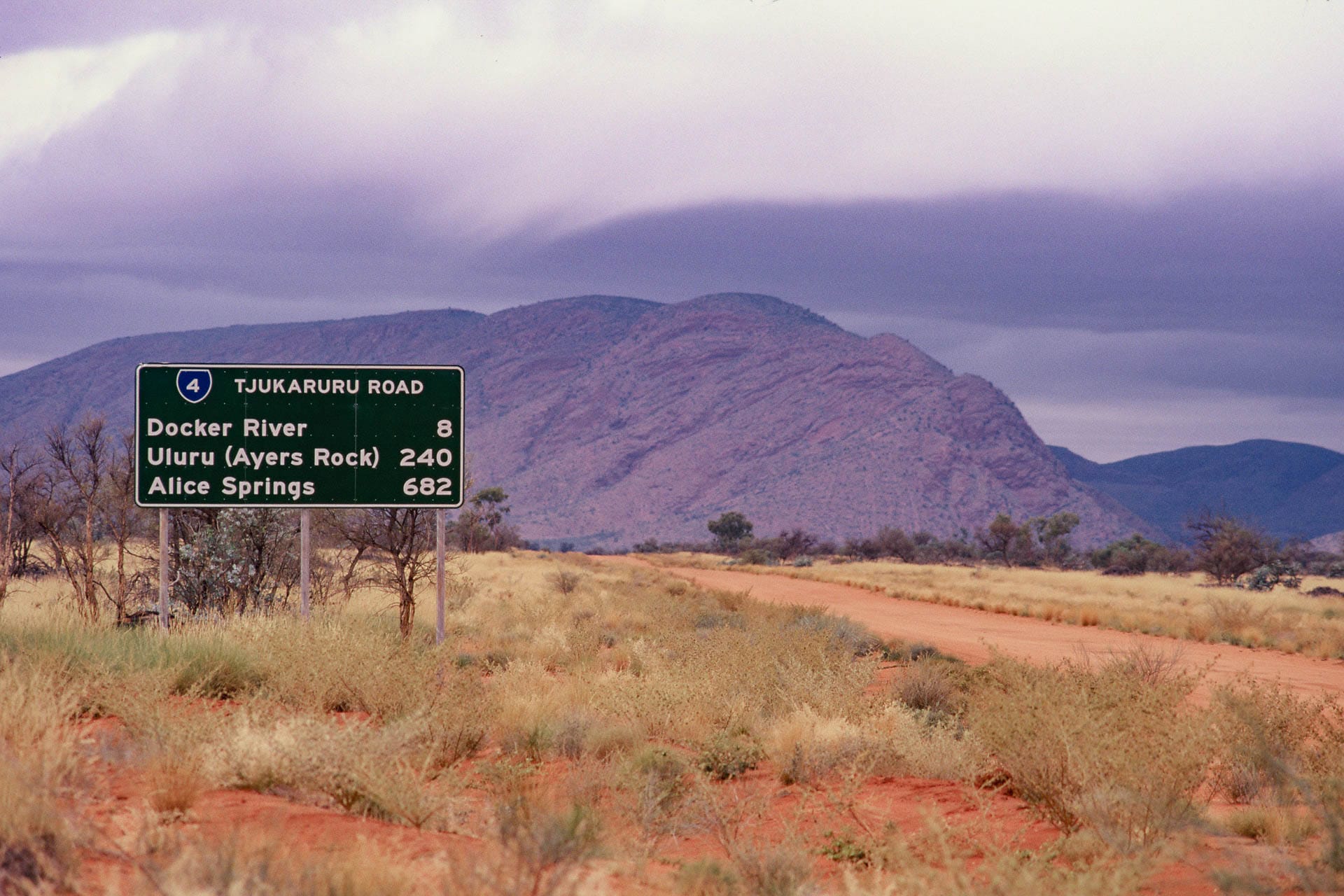
Great Central Road – A Guide to Driving the Great Victoria Desert from Leonora to Uluru
Jane Pelusey
News writer.
Jane traded her job as a trauma nurse for adventure and travel. With her photographer husband and based in Perth, they have travelled 50 countries, writing over 90 books, and learning how to map trails along the way. Trails are her thing: hiking, 4WDing, and gourmet.
- Author Profile
Learn about We Are Explorers' Editorial Standards
Experience the Great Victoria Desert from the Goldfields to Kata Tjuta and Uluru on the Great Central Road.
We acknowledge that this adventure is located on the traditional Country of the Pitjantjatjara, Ngaanyatjarra, and Yankunytjatjara peoples who have occupied and cared for the lands, waters, and their inhabitants for thousands of years. We pay our respects to them as the Traditional Custodians and recognise that sovereignty was never ceded.
Jump to Section
Quick overview.
The Great Central Road is a 1,237km road trip through the Great Victoria Desert from the Western Australian Goldfields to Kata Tjuta and Uluru in the Northern Territory’s Red Centre. Beginning at Leonora, 830km north-east of Perth , the road heads east into the desert.
Read more: Explore Kata Tjuta
About the Great Central Road and Great Victoria Desert
The Great Central Road winds its way through the Great Victoria Desert. It’s the ‘back road’ from Western Australia to the Northern Territory for those who want a true desert experience. Leaving the Golden Quest Discovery Trail at Leonora, continue on to another gold mining town, Laverton.
Read more: Australian Deserts – Everything You Need to Know About Australia’s 10 Deserts
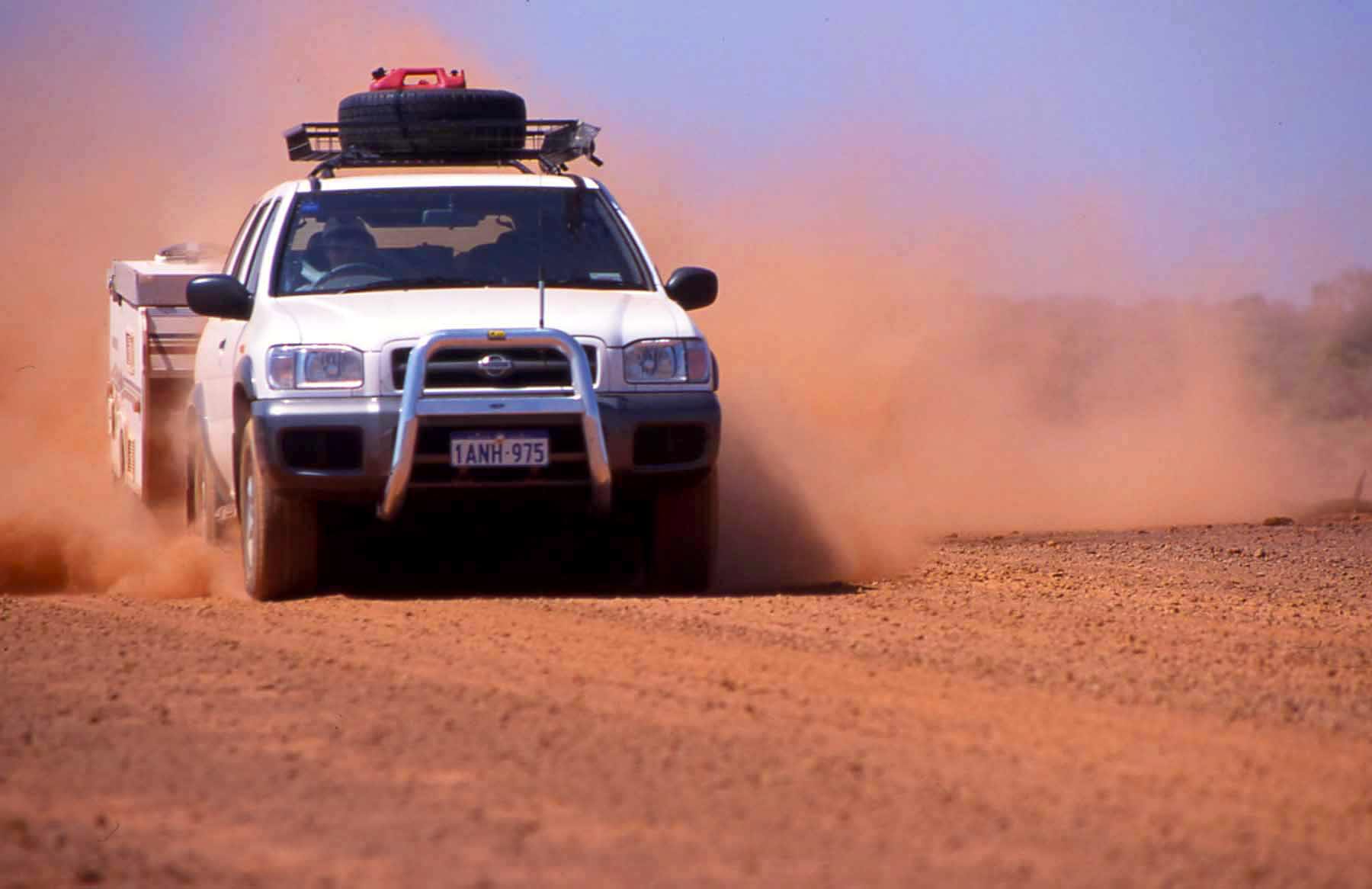
Driving the Great Central Road
The road is mainly gravel dirt with small bitumen sections. There are a couple of Indigenous communities, an amazing art gallery and interactive museum, the most remote weather station in Australia, a roadhouse in the middle of nowhere, sand dunes and breakaway country. To get most of the road trip, it takes 3-5 days.
Read more: Remember to leave no trace

History the Great Central Road
Pitjantjatjara, Ngaanyatjarra, and Yankunytjatjara people have been living in this desert for at least 20,000 years. Pitjantjatjara are also known as the Spinifex people.
Ernest Giles was the first European to cross the desert, naming it after the reigning monarch at the time. He named Kata Tjuta, Mount Olga, and Lake Amadeus after European royalty.
In the 1950s, Australia gave the United Kingdom some land known as Emu Flat in the Great Victoria Desert for nuclear bomb testing.
In the 1950s and early 60s, Len Beadell, surveyed the desert and created some 4WD tracks such as the Gunbarrel Highway, Anne Beadell and Connie Sue Highways.
The Great Central Road started in the 1930s as a track to Warburton. In 1978, funding was given to build a road from Warburton to Docker River in the Northern Territory .
How to Get to the Great Central Road?
The Great Central Road through the Great Victoria Desert is an epic road trip and can only be reached by 4WD. Drive to Leonora, 840km west of Perth, or in reverse, start at Uluru.

The Great Victoria Desert
Where to Stay Along the Great Central Road
The Great Central Road is essentially a camping adventure. There are caravan parks in Leonora, Laverton, and Warburton.
Accommodation is available at Tjukayirla Roadhouse and Warakurna Roadhouse. At the end of the trip, the accommodation options are at Yulara, the town servicing Uluru.
Read more: 5 Unique Ways to Experience Uluṟu Without Walking on it!
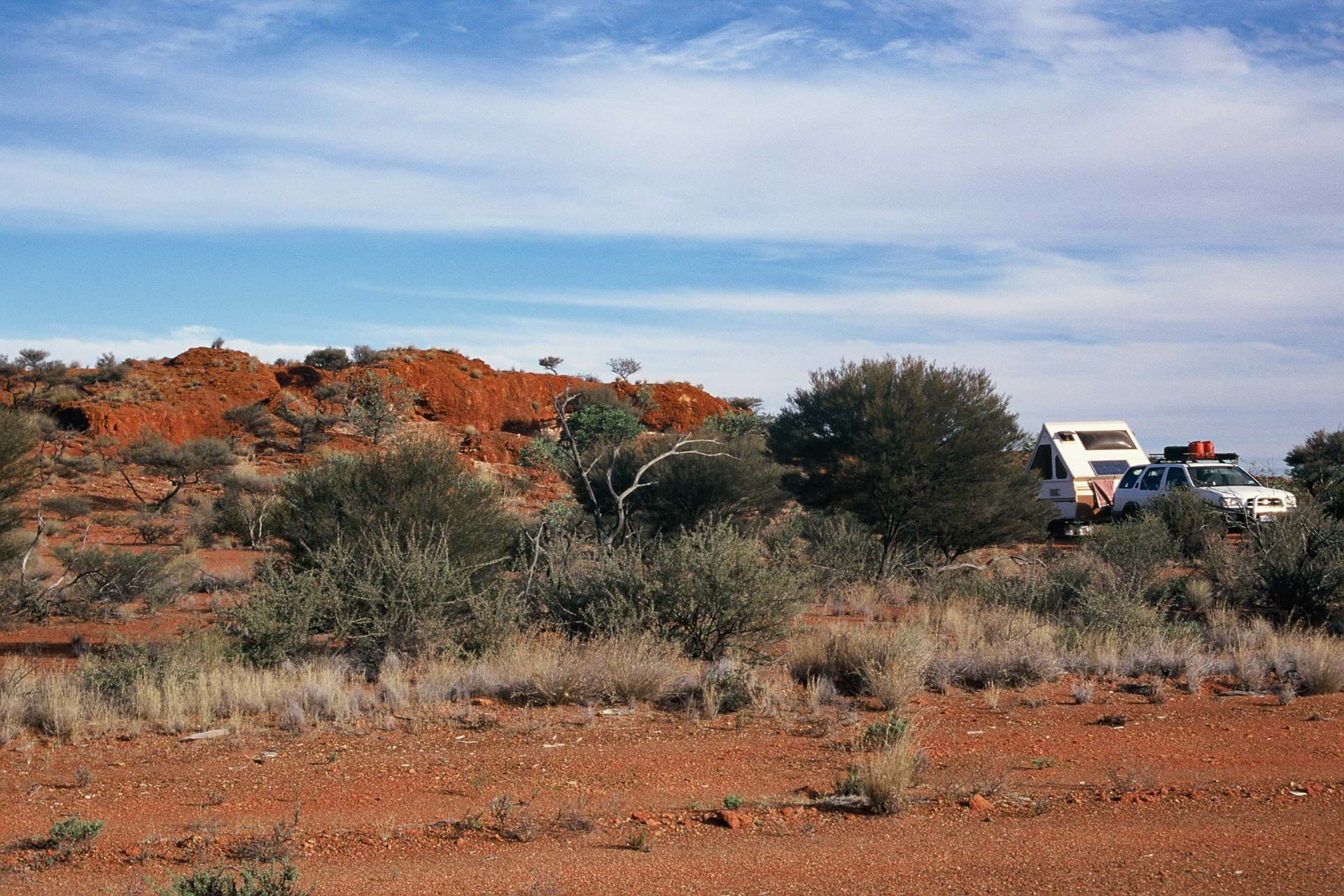
Rough camping in the desert
Where to Eat on the Great Central Road
There’s a pub at the beginning and end of the road, Leonora, Laverton, and Yulara. In between there are two roadhouses with some food. Otherwise, it’s a self-catering trip and supplies are very important.
Things to do on the Great Central Road
- Gwalia and Gwalia Museum
- The Great Beyond Visitor Centre , Laverton
- Tjulyuru Cultural Centre and Art Gallery, Warburton
- Giles Weather Station weather balloon release
- Space junk at Giles Weather Station
- Lasseters Cave
- Petermann Ranges
- Kata Tjuta and Uluru
Skill Level
Intermediate
To drive the Great Central Road you need experience and skill 4WDing on rough and sandy sections of road. It’s highly recommended to drop your tyre pressure to negotiate the soft sections and make it a more comfortable ride.
Travelers need to be self-sufficient and confident in being in the middle of nowhere. Traffic does pass by, but they may be few and far between.
Read more: How To Prepare Your Car For A Road Trip
Distance / Duration
1237km / 4 days
Read more: The Ultimate Road Trip Through The Red Centre Way
Essential Gear for the Great Central Road
- Permits are required from both the Northern Territory and Western Australia
- First aid kit
- Enough water for each person for every day
- Food for multiple days
- Spare tyre or two
What it’s Like to Drive the Great Central Road
Driving the Great Central Road is a true Outback desert experience. The roads are a mix of sealed and unsealed, the dirt is red, and the animals are interesting.
It’s not uncommon to see camels wandering in the bush and hear dingoes howling at night. The drive passed through Indigenous communities and genuinely remote roadhouses.
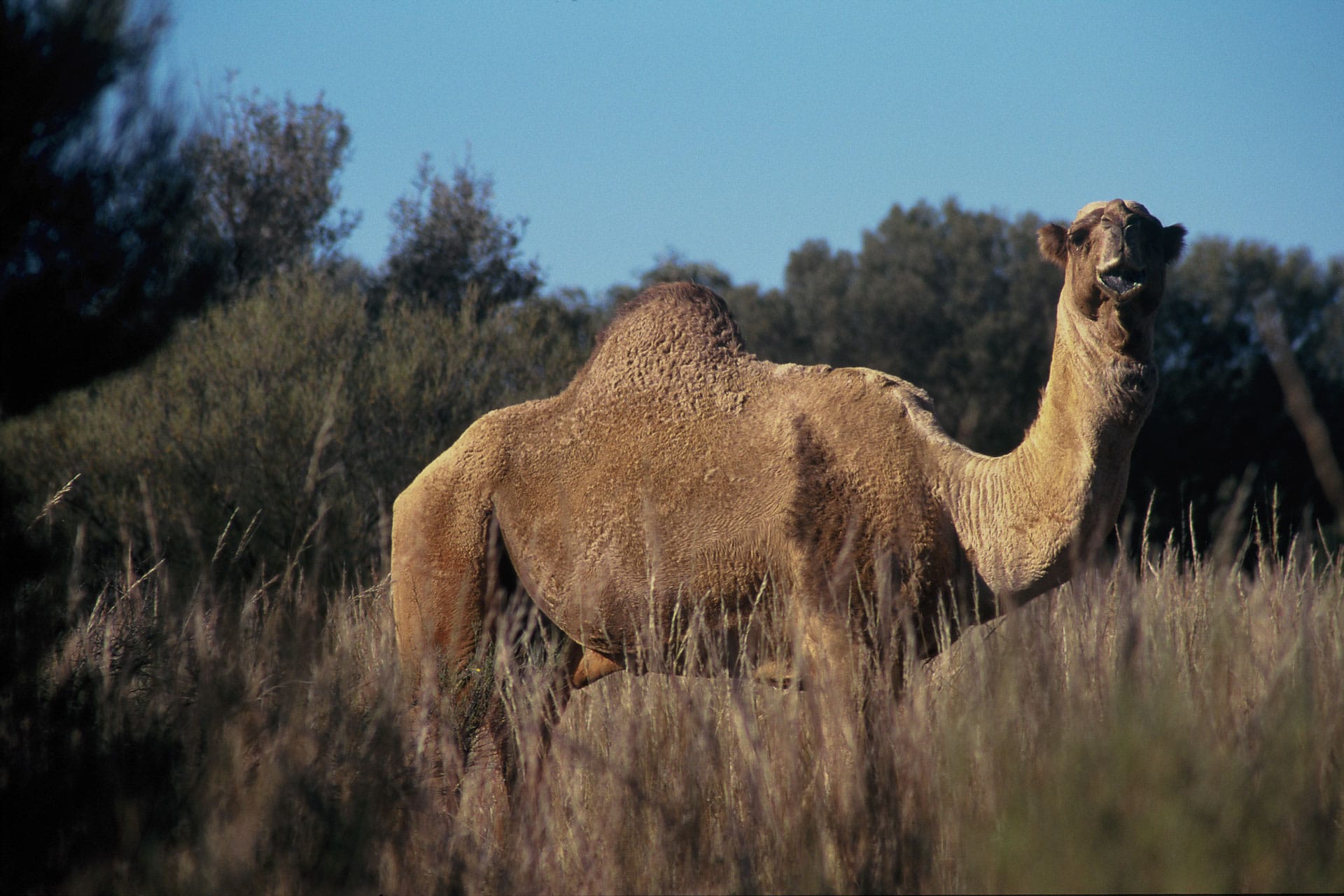
Camels are a common roadside sighting
I’ve divided the drive between settlements, but highly recommend having at least one rough camp. Wikicamps gives some of the possible options. We chose an area with rocky breakaways that lit up at sunset.
There are plans for this road to be sealed, so before it gets too busy, it’s a great time to experience the current remoteness.
Day 1 – Leonora to Tjukayirla Roadhouse
Distance: 419km Duration: 5 hours
Leonora is a small goldfields service town with a twin town of Gwalia right next door. Gwalia was a settlement for the workers of the sons of Gwalia gold mine.
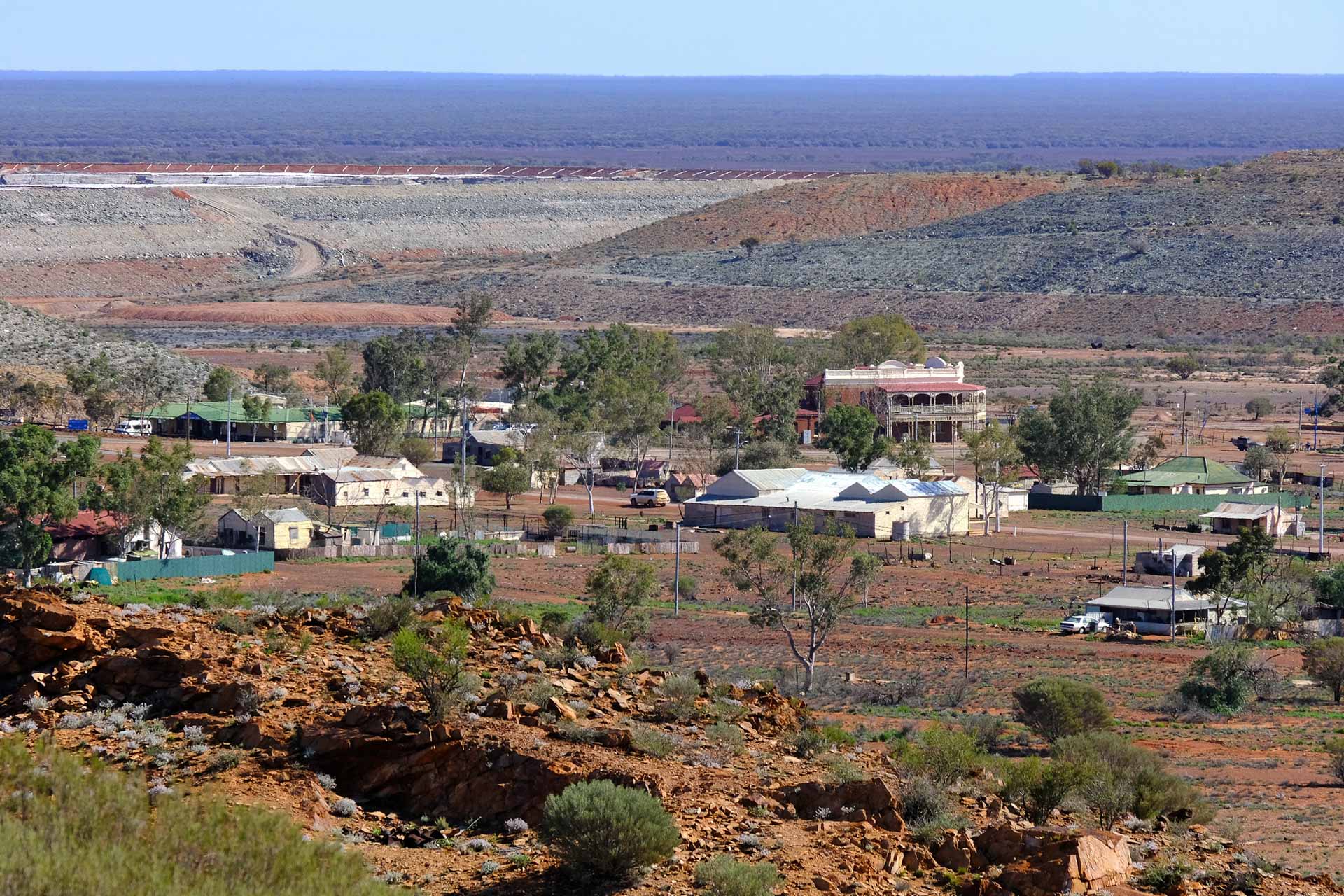
Gwalia/Leonora
Around 1897, Herbert Hoover ran the mine until he was transferred to China. Later, he became the President of the United States. Take time to explore Gwalia and its museum on the edge of the Sons of Gwalia goldmine pit.
Laverton is on the edge of the Great Victoria Desert and is predominately a gold and nickel mining area. Before heading into the desert in earnest, the Great Beyond Visitor Centre is worth a visit to understand what it was like crossing the desert for the early explorers.
The road east cuts through Cosmo Newberry, a remote Aboriginal community just off main road. A permit is required to pass through here that needs to be applied for in advance. There’s fuel and a shop in the community if needed.
Halfway between Cosmo and Tjukayirla is Yeo Lake Nature Reserve which has great wildflower displays in spring. Gnamma holes, which are natural cavities commonly found in hard rock, are dotted along the drive.
About 80km west of Tjukayirla Roadhouse, there are a few places to stop and see where the First Nations people and explorers found water.
Tjukayirla Roadhouse has fuel, accommodation, supplies, and food.
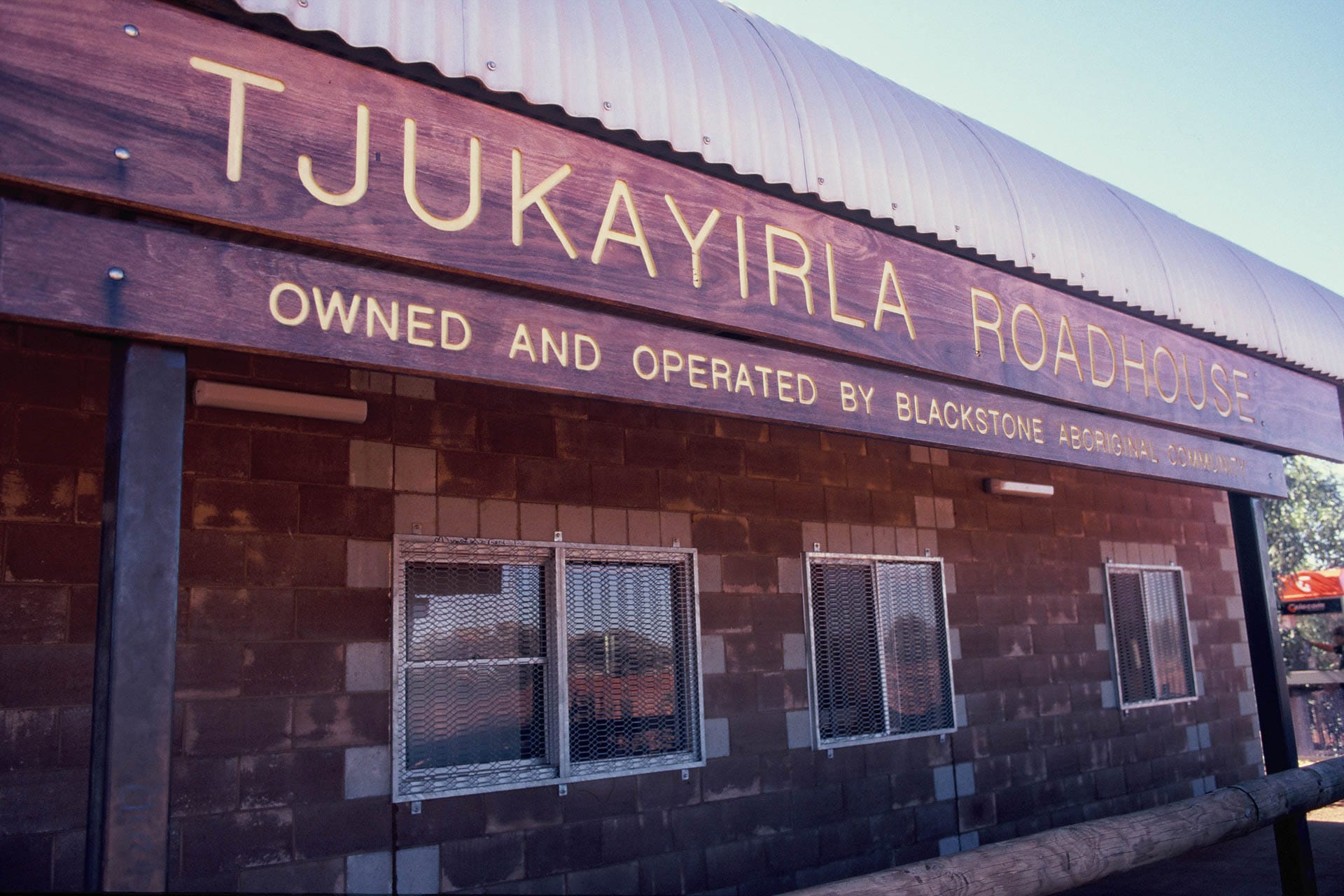
Tjukayirla Roadhouse
Day 2 – Tjukayirla Roadhouse to Warburton
Distance: 245km Duration: 4 hours
This is red sand dune country, with intermittent rocky outcrops along the way. The sand dunes are covered with a surprising number of shrubs including prickly spinifex. Keep an eye out for camels and reptiles like thorny devils.
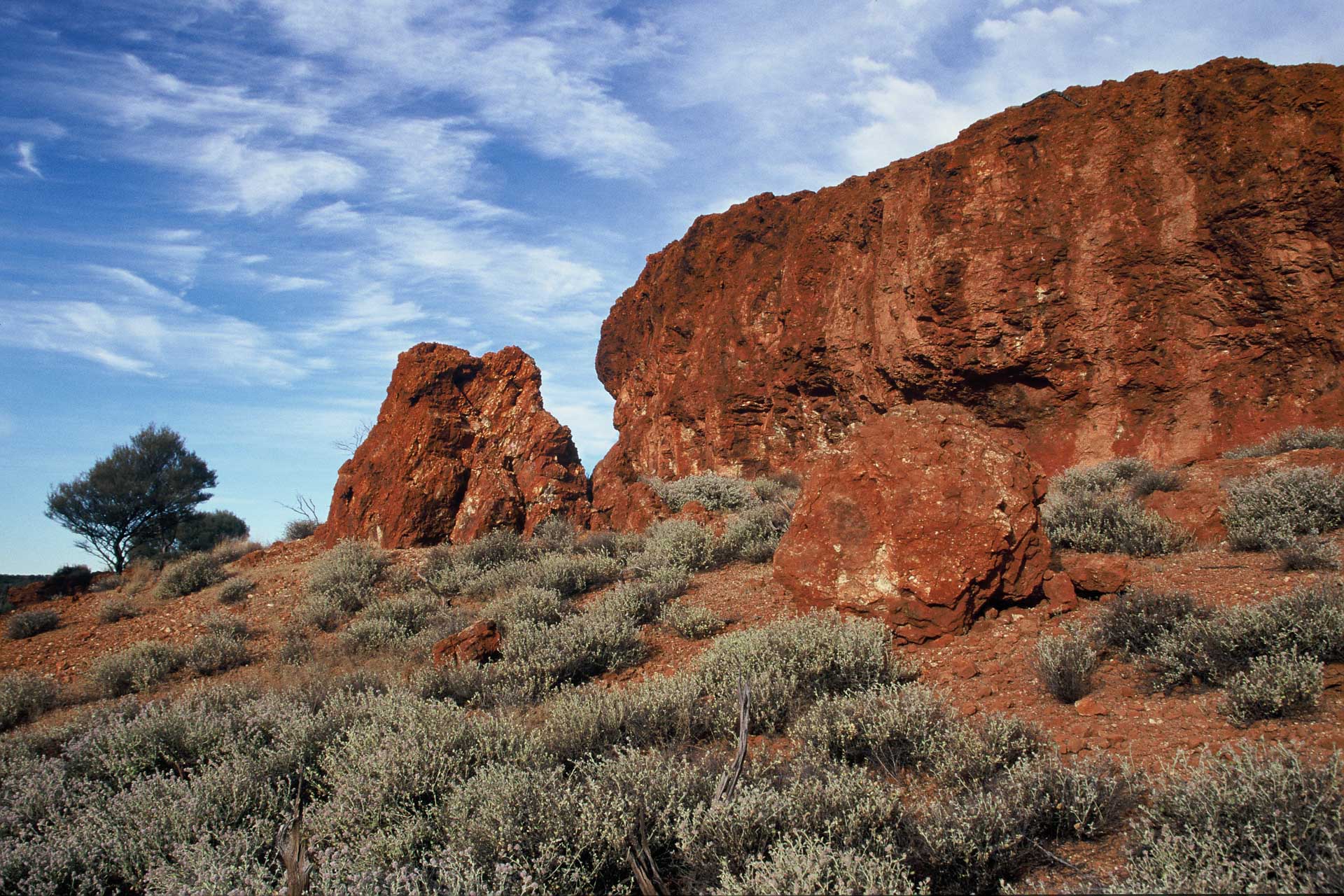
Warburton or Mirlirrtjarra is an Aboriginal community of about 600 people. This is part of the Western Desert cultural bloc. There’s an amazing art gallery, home to the Papunya Tula art movement. The Tjulyuru Regional Arts Gallery is open Monday to Friday 8.30am to 4pm. Other days it’s open on request.
The Warburton Roadhouse has all essential supplies plus accommodation, including both rooms and camping options.
Day 3 – Warburton to Warakurna
Distance: 233km Duration: 4 hours
Today is a true Outback experience with vast skies and desert that rolls on forever.
Warakuma is home to the most remote weather station in Australia named after early explorer, Ernest Giles. Around the Giles weather station is some interesting space junk leftover from the rocket testing days in the 1950s. We hung around for the release of the morning weather balloon at 8.45am.
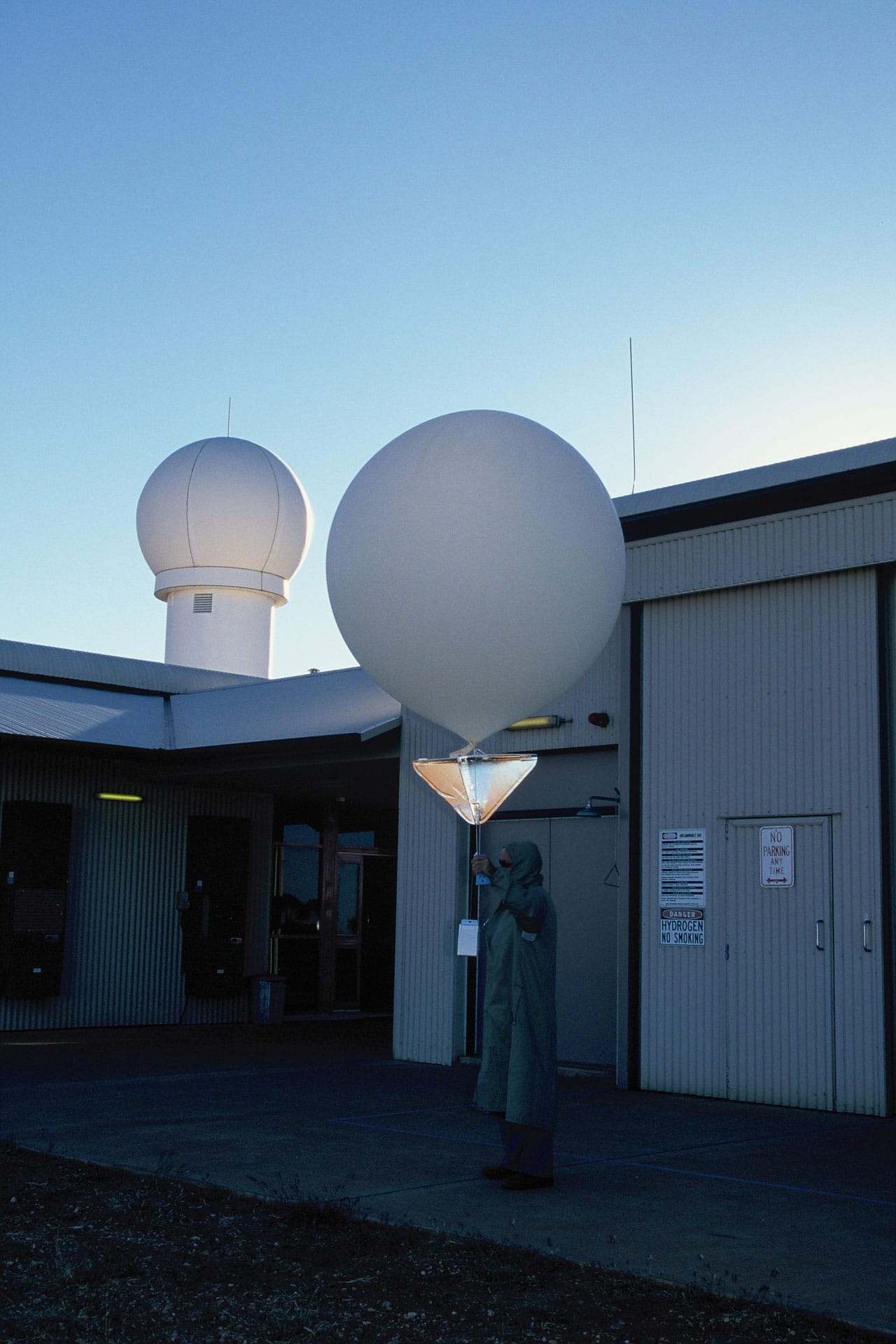
The morning weather balloon!
Even though you’re still in WA, the Warakurna Roadhouse and Giles weather station operate on Central Standard Time (CST) time, not Western Australian time.
While camping here for the night, we listened to the dingoes howl as we went to sleep. Never feed or approach dingoes as they’re wild animals.
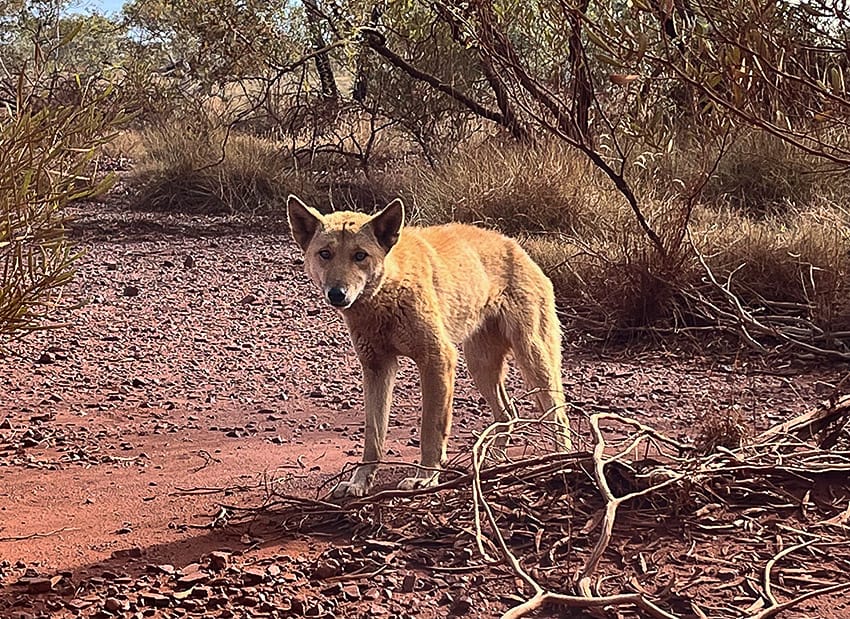
A scruffy-looking dingo
Day 4 – Warakurna to Uluru via Docker River
Distance: 340km Duration: 5 hours
The landscape dramatically changes as the Petermann Ranges rise out of the red desert. The vegetation changes from low scrub to taller bloodwood and Desert oak trees.
Just over the WA/NT border is Docker River/Kaltukatjara, another Aboriginal community. Again, a permit is required to drive through here and is available online. Docker River has most supplies including fuel.
Lasseters Cave is the stuff of legend and where gold prospector, Lewis Harold Bell Lasseter, sheltered when his camels had bolted. He claimed to have found Lasseter’s Reef, a rich desert gold deposit in 1930. While plenty of would-be prospectors have tried, the reef of gold has never been found.
Past the Petermann Ranges the drive turns into a rollercoaster of red sand dunes. At the crest of each dune, you gain a tantalising view of distant purple rocks that become bigger and more recognisable at Kata Tjuta.
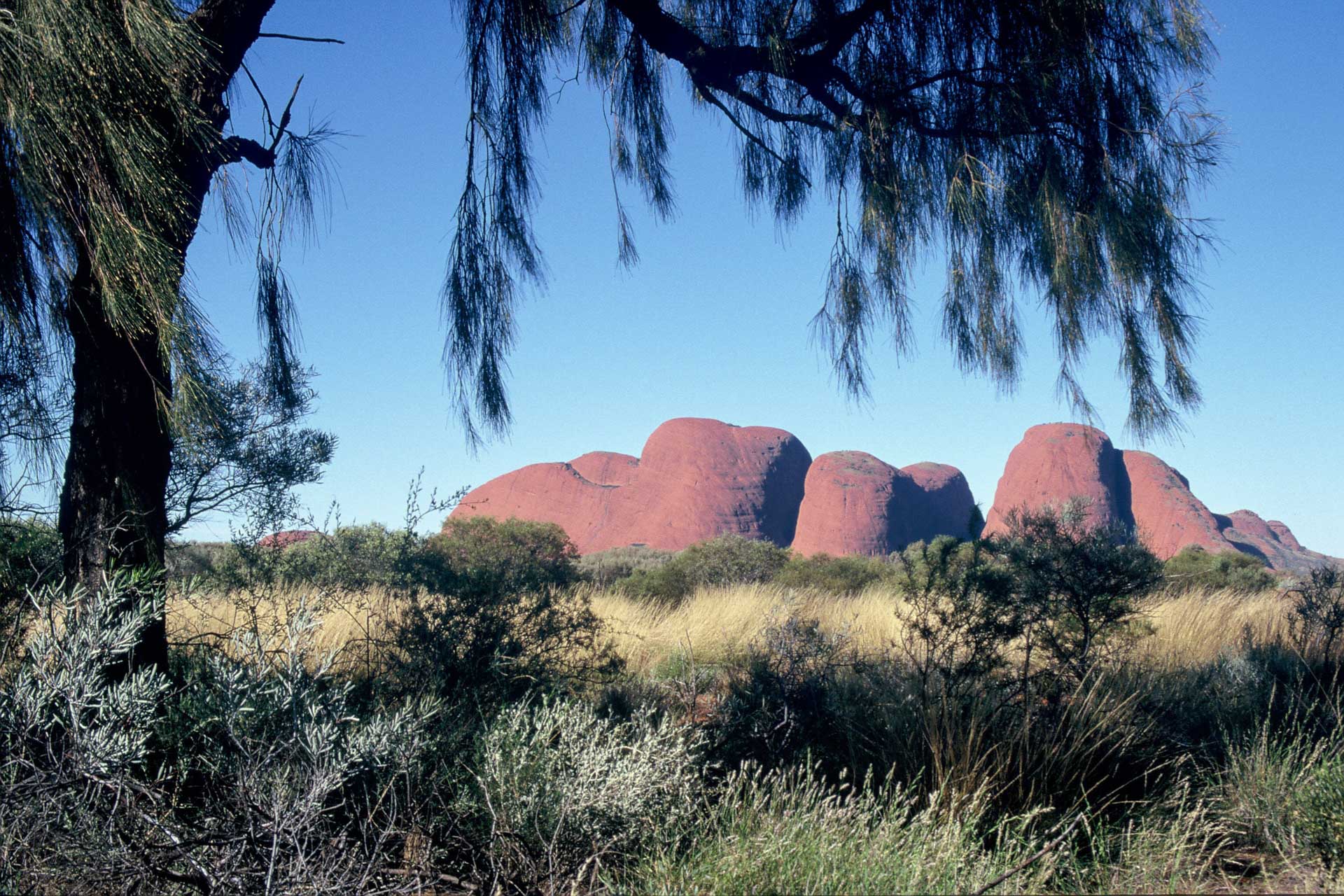
Kata Tjuta and Desert oak
Be aware that after four or five days in the desert, reaching the very busy bitumen roads at Kata Tjuta and Uluru filled with busloads of tourists can be a culture shock.
Arriving at Kata Tjuta and Uluru the back way means you’ve bypassed the National Park gate, and will pass through as you exit the park and head to Yulara, the accommodation township for Uluru. To go back in and explore more, a Uluru-Kata Tjuta National Park pass is $38 for three days.
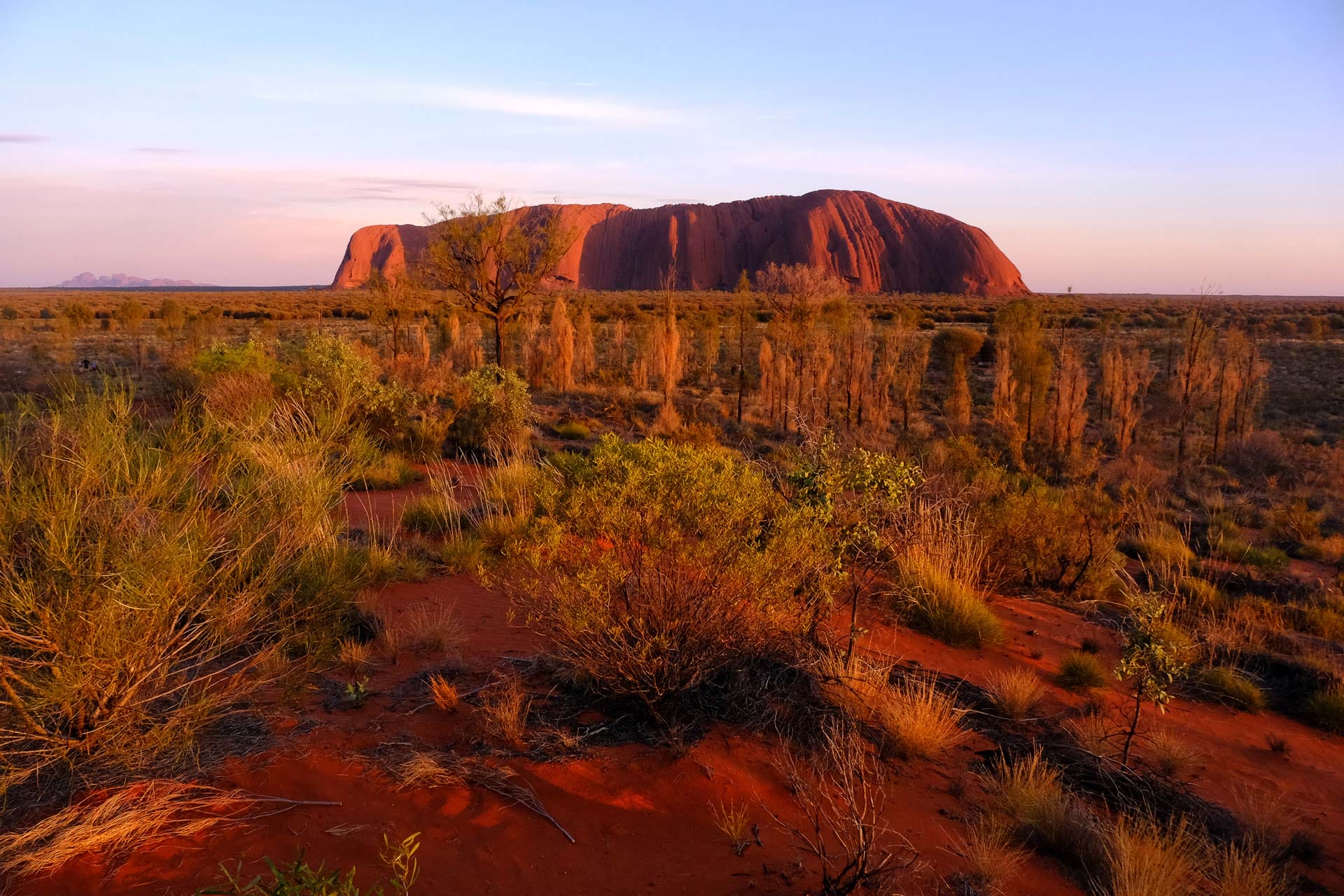
Tips to Driving the Great Central Road
- Past Laverton there are five remote roadhouses along the road but plan and be prepared. Refuel at each one unless you have a long-range fuel tank
- Make sure you know how to change a tyre and do basic car checks like oil and water
- To even out the ride, lower your tyre pressures to around 20-25 psi
- Avoid driving in summer as it’s blisteringly hot
- Be aware that rain can close the road so watch the forecast beforehand
- Mobile phone coverage is very limited-to-non-existent.
- We took a UHF radio for short range communication. Some people take an EPIRB or Spot device to send an alert message in an emergency
- Tell someone you know when you start and arrive at your destination
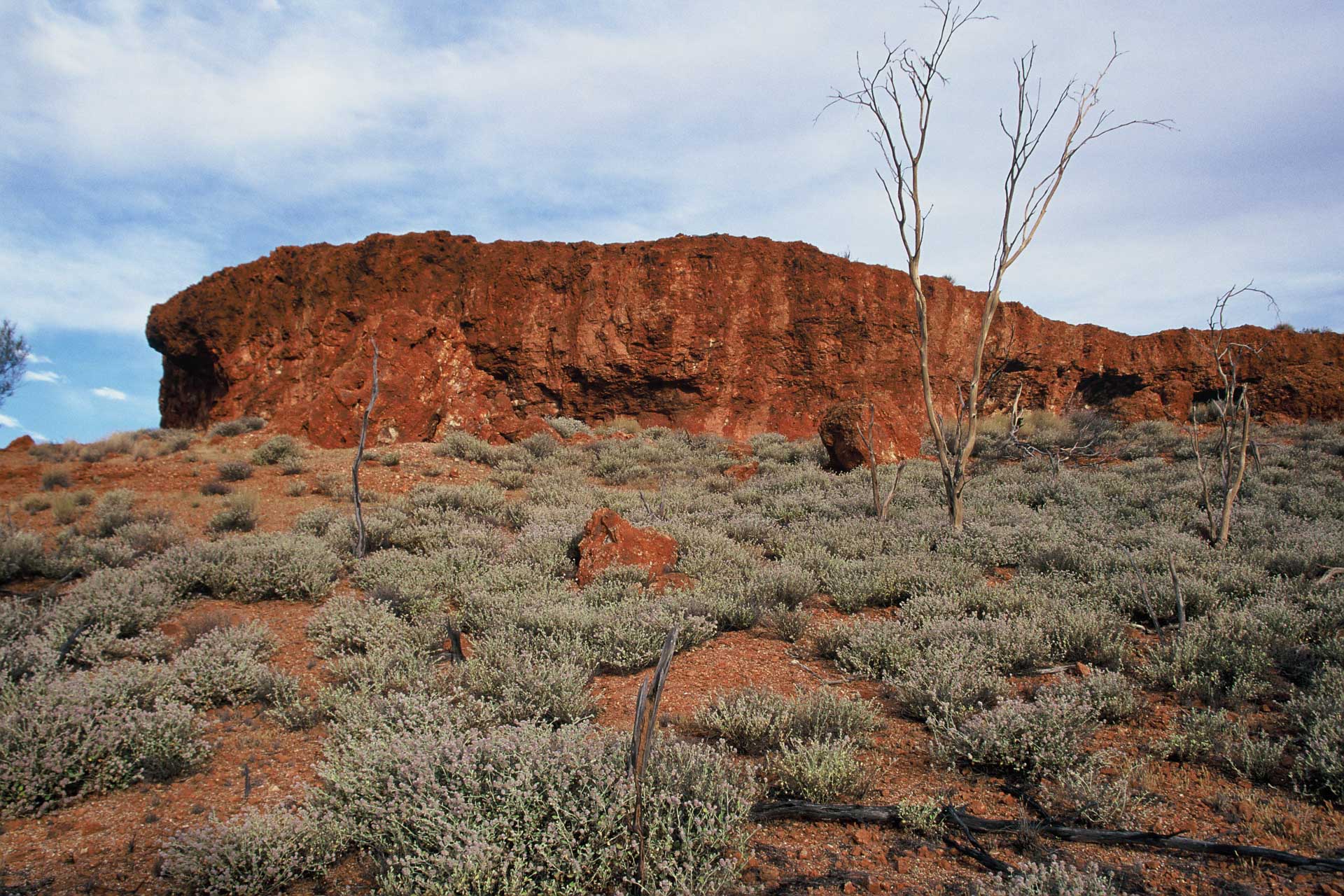
FAQs the Great Central Road
Where is the great central road located.
The Great Central Road is located between Laverton and Uluru in the Great Victorian Desert
How do you get to the Great Central Road?
The start of the Great Central Road is in Laverton, a 10.5 hour drive from Perth. Alternatively if you’re in the NT, you can start the drive at Uluru, a 5 hour drive from Alice Springs.
When is the Great Central Road open?
The Great Central Road is open year round unless it’s closed due to rain.
When is the best time to drive the Great Central Road?
The best time to drive the Great Central Road is autumn and spring. Summer is very hot, and winter can be very cold when it can drop to below zero at night.
How long does it take to complete the Great Central Road?
We tooks four days to drive from the Great Central Road from Leonora to Uluru. It can be done quicker but always drive to the road conditions.
How long is the Great Central Road?
The Great Central Road is 1,237km.
Can you swim at the Great Central Road?
No, there’s no permanent water on the Great Central Road
Do you need a 4WD to get to the Great Central Road?
Yes, a 4WD is essential to drive the Great Central Road.
Do I need permits to drive the Great Central Road?
Permits are required from both the Northern Territory end and the Western Australia end.
MORE OUTDOOR ACTIVITIES

The Great Central Road. Everything you need to know.
- by Warren and Emma

Everything you need to know about crossing The Great Central Road from WA to the NT.
Sometimes the path less travelled can be one of best. Which is why, when planning a trip to Uluru from our hometown in Perth, Western Australia we decided to take a shortcut across The Great Central Road.
The Great Central Road is part of The Outback Way, also known as Australia’s longest shortcut. Spanning 2,700km from Laverton in Western Australia, through the Northern Territory finishing in Winton, Queensland.
This great Australian road trip takes you through some of the most barren, isolated land. However, it is certainly not boring…there’s a lot to see and some things you may not expect from a trip across Australia.
That’s right…that’s a camel…in Australia!!! Emma was so excited, it was a bucket list item for her to see wild camels. After eagerly looking out of the window for hours on end we actually spotted this one initially in the middle of the road.
Planning the Trip
As a couple who love to immerse ourselves in Australian culture one of the places we just had to see was Uluru. So we set a date and started planning. As adventure lovers there was no intention of flying so we started planning an awesome Aussie road trip. Soon we realised the quickest way to get there was to take this gnarly road right through the middle of Western Australia known as The Great Central Road.
After watching a few YouTube videos and spending hours online researching we embarked on this epic journey. Not really knowing the toll the road would have on us and the car but we weren’t deterred.
Preparing the Car for The Great Central Road
According to several accounts, there are over 200 wrecked cars spattering the roadway. It was our intention not to be one of them, so before setting off Warren had our Toyota Prado set up for the trip. The Prado already has a full upgraded suspension kit, and although a suspension lift is recommended, it’s not essential to complete the journey. Tyre pressures and speed adjustments are essential to accomodate the incredible amount of corrugations.
A good set of all terrain tyres are recommended. We run Toyo Open Country and they didn’t miss a beat. A full service, coolant, oil and brake check should be carried out before the trip. We witnessed a few breakdowns along the way and tyre choice seemed to be the main culprit. We would suggest bringing a spare tyre and a good tool kit.
The Great Central Road is a key route for several Indigenous communities. The road itself passes through Indigenous land, therefore you will need permits to access parts of The Great Central Road.
You must apply for permits to travel from Western Australia to the Northern Territory via The Great Central Road. Both are free but are a requirement when taking this route.
The first permit will allow you to commute through Cosmo Newbery and The Ngaanyatjarra Central Reserve onto the Northern Territory Border. You will need to apply online via Ngaanyatjarra Council .
The second permit you must obtain covers the area from the WA/NT border along Tjukaruru Road to Uluru—Kata Tjuta National Park. Applying for the Northern Territory permit is a straightforward. The Central Land Counci l must approve the permit prior to your travel.
Setting out
So your permits are approved and every inch of your the car is checked. Bolts are tightened, the fridge is stocked and the day has finally arrived. It’s time to take the 2,046km trip from Perth to Uuru!
The first major point of interest is Kalgoorlie – Australia’s largest outback town. Kalgoorlie has plenty of points of interest should you wish to stop, however we were too keen to hit the road. Fuel tanks full we headed to Laverton, the entry point for The Great Central Road.
Soon after leaving the bitumen, the road becomes gravel and within minutes wrecked cars are visible. Flipped, broken, burnt out left in the bush to rust – we counted 7 in 20 minutes!
Be aware, the corrugations hit early and don’t let up for most of the 2,000km. Road conditions change from hard limestone, to rock and shale. To pea gravel and then to harder gravel often and without warning.
Fuel on The Great Central Road
Fuel is scarce in these remote areas. Not only is it harder to come by, but in these remote communities they do not sell regular unleaded fuel, “Opal” is the alternative. The fuel has been altered to remove the aromatics to reduce the likelihood of it being used as a drug (petrol sniffing is a horrible epidemic in some of these remote communities). Opal is slightly lower octane and is safe for all unleaded cars. We had no trouble using it, and did not see a noticeable difference in fuel economy. Diesel is readily available as well.
Fuel Prices
Prices will vary, from shocking, to absolute daylight robbery. The most we paid per litre was around $2.90 (September 2022). It is highly recommended that you carry extra fuel. Distances between roadhouses can be almost 660 km if one of the roadhouses is closed.
Carrying extra fuel is highly recommended – we took two 20l jerry cans, and some emergency fuel on the roof (a small 15l container). Filling up before hitting the road can certainly save you some money.
Laverton is the last place to obtain high-octane fuel, so we filled the car and jerry cans with premium unleaded. It is also recommended that you lock your jerry cans. A couple of bike locks from Kmart will do the trick but we had no troubles.
Corrugations can rattle nuts, bolts and screws loose so it is important to stop regularly to check your vehicle(s). We did exactly this only to discover it wasn’t a loose screw we had to contend with…our rear window took a beating.
You hear all kinds of knocks out here and when we heard another on the back of the car we didn’t think much of it. Stopping for a routine check we discovered our rear windscreen was shattered. It is likely a rock was thrown up, bouncing off the trailer and back onto the window. Nothing a roll of tape couldn’t fix, and a second (very expensive) roll from the next road house. Believe it or not this held the whole two week trip which included even more crazy corrugations – thank you window tinting!
Stops Along the Way – Points of Interest, Camps, Road houses
Tjukayirla is the first roadhouse you will see if you’re travelling West to East. It was closed on our trip as it was a public holiday. Planning ahead is key, these outback road houses aren’t 24/7 and can also run out of fuel and supplies and you don’t want to run out of fuel out here.
It is recommended that all travellers only purchase what is required. Getting supplies to these areas can be very difficult. These road houses help support the local Indigenous commutes with vital supplies.
Essentially we only stopped to get fuel twice, and did not need to purchase any extra supplies (except tape). We strongly suggest taking all food and water you need for the journey.
Travellers can also camp at all of these road houses. We would highly recommend camping on the road however as the remote campsites just look incredible.
The Last Roadhouse before the NT Border
The final road house you will see before crossing the Northern Territory border is Warakurna. Warburton also has a roadhouse should you need to fill up somewhere in the middle. However, Warakurna was an experience! It was bustling (or as bustling as you can get in the middle of the outback) and seems to be a key place for the Indigenous people in the surrounding communities to stock up on supplies.
The lack of fresh produce here however is an eye opener (particularly for Warren who is a qualified nutritionist), as in there wasn’t any! The food choices were frozen or canned and incredibly expensive with very little nutritional value. We saw one gentleman purchase a couple of party pies and some soft drinks which cost him over $50! It’s understandable that the roadhouse is over 1,000km from the city and the logistics of providing fresh produce would be incredibly difficult and costly. However, it was something that we really struggled to comprehend and made us realise how lucky we are are.
The Highlight!
If you visit Warakurna Roadhouse you will more than likely be entertained by Nathaniel’s dad jokes as he fills your car with fuel. The bigger your tank the more jokes you get – win! Nathaniel totally made our day.
Camping On the Great Central Road
There are plenty of campsites to stay along The Great Central Road. We recommend checking these out on WikiCamps . If you haven’t used WikiCamps before we highly recommend it, we have found some great places to stay on our travels using this app. You can also download the offline map if you know you are heading somewhere without phone reception.
We marked a few spots on WikiCamps and found a beautiful campsite way off the main road which turned out to be quiet and felt very safe.
It’s important to be mindful when choosing a campsite on The Great Central Road. As you will be travelling through Indigenous land some of these sites could be sacred.
Naturally, there are no campsites out here with any facilities so all travellers must be self-sufficient. If you want to check out what we brought on the trip for a comfortable camping experience check out our camping set-up post.
Points of Interest on The Great Central Road
Lasseter’s Cave and the Giles Weather Station are some of the points of interest along The Great Central Road. The Giles Weather Station release the daily weather balloon at 8:45 CST. The general public are welcome to participate in this daily occurrence which plays an important role in weather and rainfall predictions for parts of Southeastern Australia.
Cue Coldplay “Cause you’re a sky ’cause you’re a sky full of stars, I think I see youuuuuu”. The beauty of being in the middle of the outback is the lack of light pollution so turn off those camp lights and look up. Depending on the time of the year and the moon phase you could get incredible views of the Milky Way.
Crossing the Border
As you approach the border the landscape changes dramatically as the Rawlinson Ranges come into view. Ultimately you end up driving straight through the middle and the views are spectacular. The road conditions across the border worsen slightly and the road becomes a little more rough, the corrugations however don’t change. On the approach to Docker River be sure to keep a look out for wild Brumby’s.
Around two hours after crossing the border Kata Tjuta (The Olgas) will come into view. It’s such an exciting moment and the views just get better and better. The gravel changes to bitumen and the signs for Uluṟu-Kata Tjuṯa National Park become visible. You’re almost there!
Getting Home
If you plan to travel back across The Great Central Road you will need to head back into Uluṟu-Kata Tjuṯa National Park. You won’t have pay to enter the National Park, however you will have to stop at the pay booth and show your travel permit.
Final Important Points – Check The Road Conditions and Have a Back Up Plan
One thing to note is that the road conditions out there can change quickly and become very dangerous.
Crossing from Western Australia to the Northern Territory was fine and we were lucky enough not to come across any closed/impassable roads. The journey home on the other hand was a different story.
We left Alice Springs and headed for the entry to The Great Central Road via access to the Uluru National Park. You have to stop at the National Park entrance and show your permit to get back onto The Great Central Road. We were advised at this point that parts of the road were closed. This was due to rain a few days prior which rendered some of the track completely impassable. We were advised that if we chose to proceed anyway and were stopped by the authorities we would be slapped with huge fines. Not to mention putting ourselves and others in potential danger.
After pulling over on the side of the road and a few expletives we realised we were about to embark on another adventure. So we headed for the South Australian border to take a huge detour home – across the Nullabour. Which turned out to be another incredible experience.
If you are taking any of the remote roads in Western Australia or the Northern Territory we recommend checking the conditions via the links below.
Road Report NT
Main Roads WA
One final final note – Australia’s longest shortcut is an absolute must, we could not recommend it enough.
Stay safe and enjoy this great Australian Road Trip.
If you want to follow our trip across the Great Central Road, through the Northern Territory and across the Nullarbor this can be found on our YouTube Channel
Leave a Reply Cancel reply
Your email address will not be published. Required fields are marked *
Save my name, email, and website in this browser for the next time I comment.

IMAGES
VIDEO
COMMENTS
Permits for passing through Aboriginal Lands are essential for visitors travelling the Great Central Road. Your permit will also provide you with important information about safe transit …
A permit is required when travelling on roads through Aboriginal land such as the Great Central Road, Tjukaruru Road and most of the roads-tracks leading off the Outback Way between …
When seeking a travel permit for along the Great Central Road (or other roads in the area) for the purpose of Transit and refuelling ONLY, please select the road (s) you wish to travel for ease of application.
Entry permits are required for entry onto, stays on and travel through Aboriginal land via non-public roads not covered by a transit permit. Visitors to communities, including outstations or homelands. Road, civil and capital works and …
The Great Central Road forms the main throughfare for the Shire of Ngaanyatjarraku. It is part of the Outback Way, a 2800km transnational link stretching from Laverton in Western Australia to …
If you’re planning to travel the Great Central Road, you’ll need information on permits, fuel and supplies. Read on… Note: This information is subject to change. Call a few of the communities before you leave to confirm …
The Great Central Road is a 1,237km road trip through the Great Victoria Desert from the Western Australian Goldfields to Kata Tjuta and Uluru in the Northern Territory’s Red Centre. Beginning at Leonora, 830km north-east …
You must apply for permits to travel from Western Australia to the Northern Territory via The Great Central Road. Both are free but are a requirement when taking this route. The first permit will allow you to commute through Cosmo …